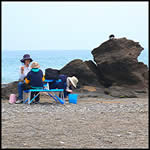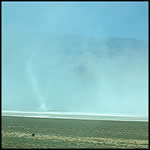Gary's Parries 16/07/06
 This week’s Gary’s Parries topics are:
This week’s Gary’s Parries topics are:
1. Digital Dust Problem 100x Worse Than Film
2. A Little Bit Rock ‘N’ Roll
Introducing this week’s Gary’s Parries column. Everything you always wanted to know about digital cameras, but were afraid to ask. No question too difficult, or too easy. As a Senior Principal Software Engineer, and a former Assistant Professor of Computer Information Systems, as well as a recording studio owner/operator, inventor, and now, a digital camera enthusiast, GARY has more digital camera knowledge in his entire brain than most people have in their little finger. In the unlikely event that GARY would not know the answer to your question, he will answer it anyway, true to the spirit of the word “Parries”, a fencing term which, in this context, implies “cleverly evasive answers”. So let your imagination run wild. Email all your nagging digital camera questions to: [email protected] , and then, En Garde!
You may also attach to your email an ORIGINAL PHOTO of your choosing. A preview of the photo will be displayed with your question, and a full-sized version will be just a click away. No personal information will be published with your question unless you specifically include it in the text or attached photo of your email, which may be further edited for grammar, content, or other reasons.
***
*** QUESTION 1—- DIGITAL DUST PROBLEM 100X WORSE THAN FILM
***
I’m just about to purchase my first digital SLR, but after researching a bit, have heard a little about static electricity build up. I’ve been told that this can lead to dust and other charged particles adhering to the CCD when you change lenses. Can you please tell me of your experiences with this and any thoughts on combating it?
Cheers,
Gregory Heap
Sydney, Australia
***
*** ANSWER 1
***
Gregory, my advice to you would depend on your level of “still” photography expertise. There are two possible scenarios: (1) you are a professional/semi-professional with a need for high-end equipment to support your photographic endeavors; or (2) you are a hobbyist/enthusiast who strives for high quality images and appreciates equipment that can produce the desired results.
In the first scenario, you would likely have been using 35mm film SLRs for quite some time; however, after much resistance and procrastination, you have finally decided to take the plunge into the world of digital photography, albeit not without some kicking and screaming. As an SLR owner, you have already been exposed to the problem of static electricity as caused by the motion of the camera’s lens mirror flipping up and down or by the motion of film winding through its body, both of which are further exacerbated by the use of its continuous shooting mode. You are also aware of the dust problems that static electricity can cause, and the pictures that can be ruined as a result of dust adhering to the film. Well brace yourself, Gregory. With digital SLRs, the dust problem is 100x worse than with film. Now hold that thought.
In the second scenario, you may have been using one or more digicams up to this point, but now feel that you are ready to step up to a DSLR. If that is the case, my advice to you is, don’t. Instead, go with a high-end digicam or bridge camera, depending on your needs. The photographic images will not be quite as good as a DSLR, but they will be perfectly acceptable for non-professional applications. And the good news is that these cameras are getting better all the time.
Returning to the first scenario, that of a film SLR user transitioning to digital, why do I say that the digital dust problem is 100x worse than film? After all, you open a camera many more times to change film than you do to change lenses. You would think that film SLRs are, for that reason, much more susceptible to acquiring dust than digital SLRs … and technically, you would be right. However, the problem in not how much dust gets into the camera, but what it does once it enters.
Think about it. What happens when dust gets into the chamber of a film vs. digital SLR? There are only two places that dust can collect where it would be visible in the final image, (a) on the lens, and (b) on the film/image sensor. However, dust that has collected on the lens will be only ‘slightly’ visible in the final image due to the distance between the dust and the image plane, which allows light to circumvent such dust, thereby dispersing its shadow. Conversely, dust adhering to the film/image sensor will be ‘highly’ visible in the final image since there is no way for light to circumvent it.
So far, the film and digital SLR dust problems seem quite comparable. For both, the biggest problem is dust collecting on the image plane surface, whether that be film or an image sensor. However, when dust gets on film, it ruins the picture, but then the film is advanced to a clean frame. When dust gets on an image sensor, it ruins each and every image until the sensor is cleaned. Therein lies the problem.
Cleaning a DSLR’s image sensor can be a nightmare. It is nothing like cleaning its mirror or lens. It can ruin the mirror, it can ruin the shutter, it can ruin the sensor, and it can cause repairs that will cost nearly as much as a new camera. That is because, in order to gain access to the image sensor, you must first stow the mirror in the up position and hold the shutter open, both under the camera’s own power. If at any time during the cleaning process the camera should lose power, the mirror and shutter will be released and come collapsing down on any brush or swab you have inserted into the chamber. And that is in addition to all the damage you can do just by using improper brushes, swabs, air propellants, cleaning solutions, or procedures.
You might say to yourself, well, I don’t really need to insert anything ‘into’ the chamber; rather, I can just use an air blower from ‘outside’ the chamber to dislodge the dust particles. Guess again. Due to the effects of humidity and image sensor heat, dust particles can become stuck on the image sensor, so much so that only very aggressive swabbing will remove them, much like the bugs on a windshield. And even if some of the dust particles were actually loose enough to be dislodged from the image sensor by the airflow, the static charge of the image sensor will attract them right back to it again. Gregory, you can’t win.
That is why camera companies recommend that, if your image sensor shows dust, you should have it cleaned ONLY by an authorized service representative, for which you will be charged a nominal fee of around $30 to $50. But it gets worse. Even after your camera is serviced, there is no guarantee that the image sensor will be dust free.
At this point, you are probably saying to yourself, okay, I’ll just buy the best all-purpose lens I can find and NEVER take it off. That may work, but then again, it may not. There have been numerous reports of image sensors with dust straight from the factory. There have also been reports of dust entering the camera through the zoom barrel of the lens.
Gregory, unless you really need a DSLR, go with one of the high-end digicams, either a compact or bridge camera depending on your intended use. If you absolutely must have a DSLR, get a single all-purpose lens, and never remove it, but be sure to check your images for sensor dust from the factory. If you absolutely cannot live with just one lens, then you will just have to do the best you can, take your chances, and join the club. :)
P.S. The Olympus EVOLT and Sony Alpha DSLR-A100 cameras have ultra-sonic vibrating CCDs to shake off their dust particles. This vibration can be activated either manually, or automatically (on power-up for the EVOLTs, on power-down for the Alpha). I have not personally tried these cameras so I cannot comment on their effectiveness. But thinking back to the bugs on a windshield analogy, how effective would a vibrating windshield be? Still every little bit helps.
P.S.S. The Sony Alpha also has an anti-static coating applied to its low-pass filter mounted in front of the image sensor. (On all DSLRs, a low-pass filter seals the image sensor from dust contamination, and this is actually where the dust accumulates.) Canon applies an anti-static charge to its image sensors to ward off dust. Nikon’s Capture software has a feature for removing sensor dust in image post-processing.)
P.P.S.S. You might also avoid shooting in dust storms like the one in the photo. :)
[Note: Here is a link to the PBase website, which has some excellent tips for removing dust from image sensors. Here is a link to the Austin American - Statesman website showing photos of some excellent Dust Art :). – Ed.]
***
*** QUESTION 2—- A LITTLE BIT ROCK ‘N’ ROLL
***
 Maybe you could answer this off-topic question. Last week I heard “Sea of Heartbreak”, that classic Don Gibson song, BUT, it wasn’t his version. It was a bit more Rock ‘n’ Roll. For the life of me, I can’t find out who may have done it. By any chance, could you tell me the version that was possibly, maybe, better than the original? Getting some CDs ready for our annual trip to Kyushu later this summer, and kinda like this song. Much thanks!
Maybe you could answer this off-topic question. Last week I heard “Sea of Heartbreak”, that classic Don Gibson song, BUT, it wasn’t his version. It was a bit more Rock ‘n’ Roll. For the life of me, I can’t find out who may have done it. By any chance, could you tell me the version that was possibly, maybe, better than the original? Getting some CDs ready for our annual trip to Kyushu later this summer, and kinda like this song. Much thanks!
Semper Fi,
Nick and Family
***
*** ANSWER 2
***
Because of their distinctive voices, I’m sure you would have recognized any version of the song sung by Johnny Cash, The Everly Brothers, Loretta Lynn, or Charlie Pride. The only version I know that is “a little bit Rock ‘n’ Roll” is by Jimmy Buffet, and features George Strait on vocal accompaniment.
Here is a link to CD Universe’s 30-second audio clip of “Sea Of Heartbreak” by Jimmy Buffet. In case that’s not the one you heard, here is their Complete Selection of “Sea Of Heartbreak” Versions by Various Artists. Click on any version to get to its audio clip. My favorites were Johnny Cash, Eddie Spaghetti, Rumbleseat, and the very Elvis sounding Robert Gordon.
P.S. Great spot for a family picnic, and an exceptionally nice spot to shoot. Your LX1 did an excellent job with the image details and color, but I had a real tough time removing what appeared to be large blotches in the sky. Was that the infamous LX1 image sensor noise?
***
[Column photo “The Photographer” by Brenda LaFleur of Brenda LaFleur Photography.]

